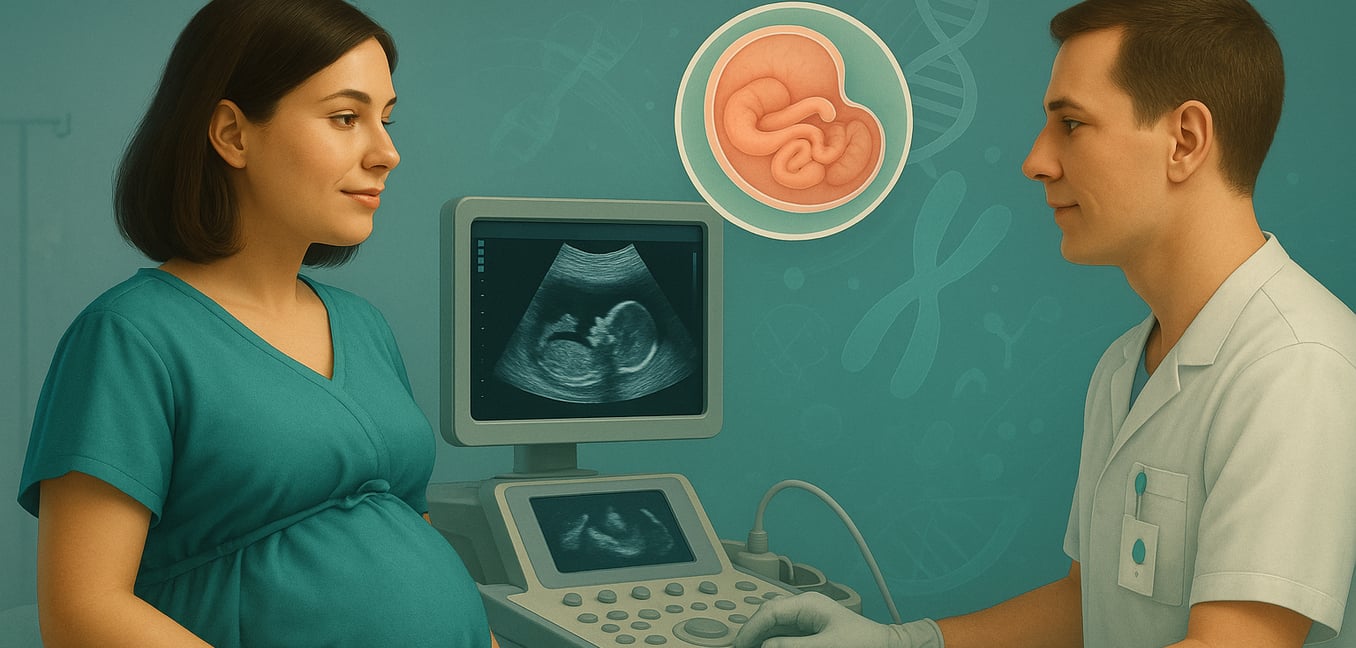What Is Omphalocele?
An omphalocele is a rare congenital condition where a baby's intestines, liver, or other abdominal organs protrude outside the body through the base of the umbilical cord. Unlike other abdominal wall defects, the organs are enclosed in a thin, protective sac. This condition occurs in approximately 3 out of every 10,000 pregnancies.
During fetal development, it is normal for the intestines to temporarily bulge into the umbilical cord. By the 12th week of pregnancy, these organs should return to the abdomen. An omphalocele happens when this process fails, leaving the organs outside.
The size of the defect can range from small, containing only a few loops of intestine, to "giant" (over 5 centimeters), often including the liver. Larger omphaloceles can be associated with a smaller chest cavity, which may lead to breathing difficulties for the newborn.
Omphalocele is often linked to other congenital anomalies or genetic syndromes, such as Trisomy 13, 18, and 21, or Beckwith-Wiedemann syndrome. The presence of these other conditions significantly influences the baby’s overall prognosis.
Given these factors, prenatal testing plays a critical role in diagnosing the condition and understanding its implications. Here are the tests used to detect omphalocele before birth.
Initial Screening: First-Line Tests
For most expecting parents, screening for omphalocele begins with noninvasive tests during the first and second trimesters. These tests assess risk and determine if more specific diagnostic procedures are needed.
First-Trimester Ultrasound
Performed between 11 and 13 weeks, this early scan is often the first opportunity to suspect an omphalocele. While it is normal for intestines to be in the umbilical cord before 12 weeks, their presence after this point is a key indicator and raises suspicion.
Second-Trimester Maternal Serum Screening
This blood test (Quad Screen), done between 15 and 20 weeks, measures a protein called alpha-fetoprotein (AFP). Elevated AFP levels can signal an abdominal wall defect, prompting a more detailed ultrasound. This is a screening test, not a diagnosis; an abnormal result simply flags the need for further investigation.
Detailed Anatomy Ultrasound
This comprehensive scan, between 18 and 22 weeks, can confirm an omphalocele. It provides critical details on the defect's size, which organs are involved, and checks for other associated anomalies in the baby's heart, brain, or limbs. This complete picture is essential for guiding discussions about prognosis and next steps.
Karyotyping: A Map of the Chromosomes
If an ultrasound detects an omphalocele, the next step is often genetic testing. A standard test called karyotyping creates a map of the baby's chromosomes to check for large-scale genetic conditions.
To perform a karyotype, a sample of the baby's cells is collected via chorionic villus sampling (CVS) or amniocentesis. In the lab, a specialist arranges the chromosomes into a standardized map, allowing them to visually inspect for abnormalities like a missing or extra chromosome (aneuploidy).
In pregnancies with an omphalocele, karyotyping most often identifies Trisomy 18 (Edwards syndrome) and Trisomy 13 (Patau syndrome). The likelihood of finding a chromosomal issue is much higher if other structural differences are also seen on the ultrasound. In these "non-isolated" cases, the rate of chromosomal abnormalities can be as high as 40%.
Interestingly, the size of the defect is a clue. Smaller omphaloceles are more likely to be associated with an abnormal karyotype than giant omphaloceles that contain the liver. For this reason, genetic testing is recommended for all prenatally diagnosed omphaloceles, regardless of their size.
Chromosomal Microarray Analysis (CMA): A High-Resolution View
For a more detailed genetic analysis, Chromosomal Microarray Analysis (CMA) offers a higher-resolution view than a standard karyotype. Think of it as moving from a satellite map to a detailed street view. CMA can detect if tiny pieces of a chromosome's DNA are missing or duplicated. These small changes, called copy number variants (CNVs), are often too small for a karyotype to see but can still impact a baby's health.
CMA is particularly useful for identifying genetic changes linked to specific syndromes. For example, it can detect a tiny deletion on chromosome 11 that is a known cause of Beckwith-Wiedemann syndrome (BWS), a pediatric overgrowth disorder sometimes associated with omphalocele. This finding provides a precise diagnosis and a clearer understanding of the baby’s future needs.
The test can also reveal when a baby inherits two copies of a chromosome from one parent instead of one from each, a rare event called uniparental disomy (UPD). While not always harmful, UPD affecting certain chromosomes can cause rare disorders. CMA flags this possibility, which cannot be seen on a karyotype, opening the door for further investigation.
Whole Exome Sequencing (WES): Reading the Genetic Code
In some cases, the underlying reason for a baby's omphalocele remains unknown even after karyotyping and CMA. This is where a highly advanced technology called Whole Exome Sequencing (WES) can be considered. If DNA is a library of instruction books, WES reads the actual text within the most important chapters—the genes.
WES is designed to find single-letter "spelling mistakes" or tiny missing words in the genetic code that can cause a gene to malfunction. This level of detail is crucial for identifying rare, single-gene disorders that are not detectable by other methods, such as Donnai-Barrow syndrome or certain disorders of bone development.
This powerful test is most valuable when a fetus has an omphalocele along with other structural differences, but both karyotyping and CMA results are normal. By pinpointing a specific genetic cause, WES can provide a definitive answer, offering parents a clear understanding of the diagnosis, the prognosis, and crucial information for future family planning.










